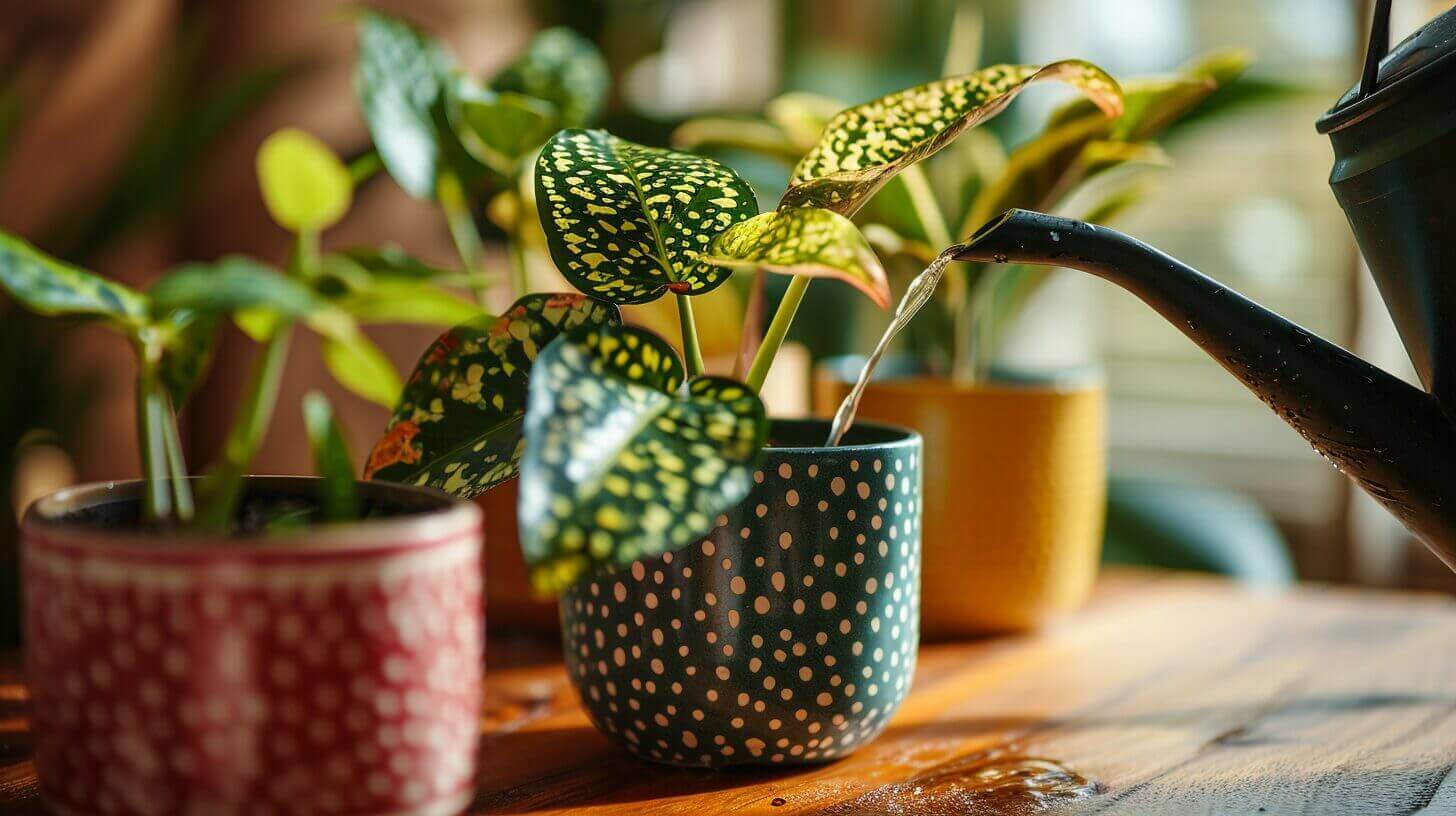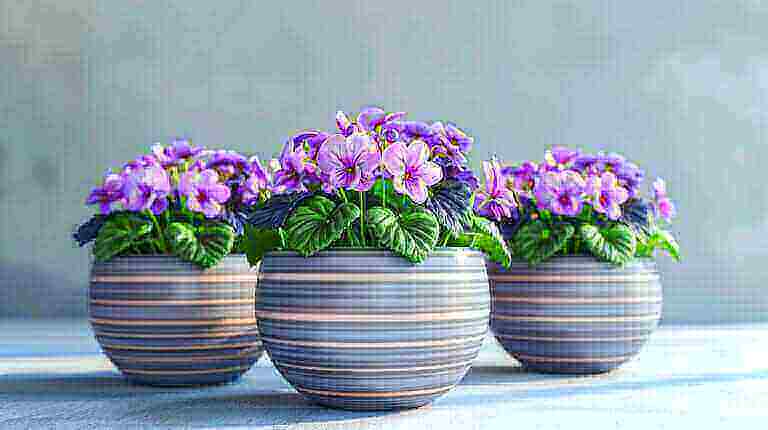How to Water Polka Dot Plants(Hypoestes Phyllostachya) Properly: Watering Amount, Timing, and Mistakes to Avoid
Polka dot plants (Hypoestes phyllostachya) are herbaceous warm-climate perennials with variegated leaves. They prefer warm, humid conditions with bright, indirect light or partial shade. To water polka dot plants properly, it’s important to keep the soil consistently moist but not waterlogged. Water the plant when the top inch of soil feels dry to the touch. Avoid overwatering, as it can lead to root rot. Polka dot house plants have a moderate growth rate and remain relatively small once mature. They are not considered invasive plants in most temperate climates, but they are invasive in some tropical areas.
Key Takeaways:
- Polka dot plants prefer warm, humid conditions with bright, indirect light or partial shade.
- Keep the soil consistently moist but not waterlogged by watering when the top inch of soil feels dry.
- Avoid overwatering to prevent root rot.
- Polka dot plants have a moderate growth rate and remain relatively small once mature.
- They are not considered invasive in most temperate climates, but invasive in some tropical areas.
Care For Polka Dot Plant (Hypoestes Phyllostachya) – Watering Amount
Determining the Right Amount of Water for Polka Dot Plants
Proper watering is crucial for the health and growth of polka dot plants. These charming and vibrant plants, also known as Hypoestes Phyllostachya, require a consistent moisture level in their soil to thrive. Here are a few tips on determining the right amount of water for your polka dot plants:
- Assess the soil moisture: Before watering, it’s essential to check the moisture level of the soil. Insert your finger about an inch into the soil near the plant’s roots. If it feels dry, it’s time to water. However, if the soil feels moist, it’s best to hold off watering until it dries out a bit.
- Avoid overwatering: Polka dot plants are susceptible to root rot if overwatered. To prevent this, it’s crucial to provide proper drainage for your plant. Make sure the pot has drainage holes that allow excess water to escape. Additionally, avoid leaving your plant sitting in water, as it can lead to waterlogged roots and subsequent damage.
- Water from the bottom: An effective way to water polka dot plants is by bottom watering. This involves placing the plant pot in a saucer filled with water, allowing the roots to soak up the moisture from the bottom. This method ensures that the roots receive the necessary hydration without saturating the topsoil excessively.
Signs of Underwatering and Overwatering
Understanding the signs of underwatering and overwatering is vital to keep your polka dot plant healthy and thriving. Here are some indicators to watch out for:
- Underwatering signs: If the leaves of your polka dot plant start drooping, wilting, or turning yellow, it may be a sign of underwatering. Additionally, dry soil and a parched appearance indicate that the plant needs more water. In such cases, increase the watering frequency to provide sufficient moisture to the plant.
- Overwatering signs: Overwatering can cause the leaves of the polka dot plant to become mushy, yellow, or develop brown spots. The soil may also have a sour smell, indicating root rot. To avoid overwatering, ensure that the top layer of soil dries out between watering sessions, allowing the roots to breathe and preventing waterlogged conditions.
Polka Dot Plant Care – Watering Timing
Best Time to Water Polka Dot Plants
To ensure the proper growth and health of your polka dot plants (Hypoestes Phyllostachya), it is essential to consider the best timing for watering. Timing plays a crucial role in optimizing the absorption of water by the plants’ roots and preventing water-related issues. Here are some guidelines to follow when it comes to watering your polka dot plants:
- Morning Watering: The best time to water polka dot plants is in the morning when the temperature is cooler and the air is less humid. Watering early in the day allows the plants to absorb moisture before the sun’s heat intensifies. It also gives the foliage a chance to dry off during the day, reducing the risk of fungal diseases.
- Avoid Nighttime Watering: It is generally not recommended to water polka dot plants in the evening or at night. Watering late in the day can leave the foliage wet overnight, creating a favorable environment for fungal growth and diseases. Moist conditions in the dark can also attract pests. Therefore, it is best to avoid watering your plants close to bedtime.
Frequency of Watering and Seasonal Variations
The frequency of watering your polka dot plants can vary depending on several factors, including the season, temperature, humidity, and the specific needs of your plant. Here are some guidelines to help you determine the watering frequency:
- Consistent Moisture: Polka dot plants thrive in consistent moisture levels, but it is essential not to overwater them. As a general rule, the top inch of the soil should be allowed to dry out slightly between watering sessions. Stick your finger into the soil to assess the moisture level before watering.
- Seasonal Adjustments: During the growing season, typically spring and summer, polka dot plants may require more frequent watering due to increased evaporation and growth. However, be mindful not to water excessively, as it can lead to root rot. In the dormant season, such as fall and winter, when growth slows down, scale back on watering to prevent waterlogged conditions.
- Humidity Considerations: Polka dot plants prefer moderate to high humidity levels. If you live in a dry climate or during the winter months when indoor humidity drops, consider using a humidifier or placing a tray of water near the plant to increase the ambient moisture.
- Watch for Signs of Underwatering and Overwatering: It’s crucial to observe your plants for any signs of underwatering or overwatering. Adjust the watering frequency accordingly if you notice drooping leaves, wilting, yellowing, or other symptoms of water stress.
Common Watering Mistakes to Avoid for Polka Dot Plants
Proper watering is essential for the health and well-being of your polka dot plants. However, there are some common watering mistakes that you should avoid to prevent issues and ensure optimal growth.
Impact of Improper Watering on Plant Health
Improper watering practices can have a significant impact on the overall health and well-being of your polka dot plants. Here are some potential issues that can arise from improper watering:
- Root rot: Overwatering can lead to waterlogged soil and root rot, which is a fungal disease that can be fatal to plants. When the roots are constantly submerged in water, they cannot access oxygen, leading to decay and root system failure.
- Fungal diseases: Keeping the foliage wet for long periods, especially overnight, can create a favorable environment for fungal diseases to thrive. Watering in the morning allows the leaves to dry off during the day, reducing the risk of fungal infections.
- Pest infestations: Excessive moisture and inconsistent watering can attract pests, such as fungus gnats, to your polka dot plants. These pests lay their eggs in the moist soil, and the larvae can damage the roots, leading to stunted growth and plant decline.
- Yellowing leaves and wilting: Improper watering can cause the leaves to yellow, wilt, or droop. Overwatering can suffocate the roots, preventing them from efficiently absorbing water and nutrients. Underwatering, on the other hand, deprives the plant of the necessary moisture, causing dehydration and wilting.
Watering Techniques
Choosing the Right Watering Technique for Polka Dot Plants
When it comes to watering your polka dot plants (Hypoestes phyllostachya), it’s important to choose the right technique to ensure their proper hydration. These plants have specific watering needs, and following the correct techniques can help prevent issues and promote their overall health and growth.
The first step in watering your polka dot plants is to choose the right watering method. There are two primary techniques to consider: top watering and bottom watering.
Watering from the Top or Bottom
- Top Watering: This is the most common method used for watering houseplants. Simply pour water onto the soil surface until it is evenly moist. Avoid splashing water directly onto the leaves to prevent the risk of fungal diseases. Top watering allows you to closely monitor the moisture levels in the soil and adjust the amount of water accordingly.
- Bottom Watering: This technique involves placing the pot in a tray or saucer filled with water and allowing the plant to absorb water from the drainage holes at the bottom of the pot. Bottom watering can be beneficial for polka dot plants because it encourages deep root growth. However, it is essential to ensure that the plant is not left standing in water for extended periods, as this can lead to root rot.
Regardless of the watering technique you choose, there are some key points to keep in mind to properly water your polka dot plants:
- Watering Amount: Polka dot plants prefer consistently moist soil. Aim to keep the soil evenly moist but not waterlogged. Overwatering can lead to root rot, while underwatering can cause wilting and stress. To determine when to water, check the top inch of the soil. If it feels slightly dry, it’s time to water.
- Watering Frequency: Develop a watering routine based on the specific needs of your polka dot plant. Factors such as temperature, humidity, and pot size can affect how often you need to water. During the warmer months or in drier environments, you may need to increase the frequency of watering. However, ensure that the soil has sufficient time to dry out slightly between waterings.
- Mistakes to Avoid: To prevent common watering mistakes, such as overwatering or underwatering, it’s crucial to pay attention to your plant’s needs. Avoid the temptation to water on a strict schedule and instead rely on the plant’s signals. Monitor the soil moisture, observe the foliage for any signs of stress, and adjust your watering routine accordingly.
Grow and Care for Polka Dot Plant Using Well-Draining Soil
The Importance of Well-Draining Soil for Polka Dot Plants
When it comes to caring for your polka dot plants (Hypoestes phyllostachya), using well-draining soil is crucial for their optimal growth and health. These plants have specific needs when it comes to moisture levels, and well-draining soil helps ensure that their roots receive the right amount of water without becoming waterlogged.
Well-draining soil is important because it allows excess water to drain away, preventing the roots from sitting in stagnant water. Polka dot plants are susceptible to root rot, which can occur when the roots are constantly submerged in water. By providing well-draining soil, you create an environment that promotes root health and prevents the risk of root rot.
Tips for Preparing the Right Soil Mix
To create a well-draining soil mix for your polka dot plants, consider the following tips:
- Choose a light and porous potting mix: Look for commercial potting mixes that are specially formulated for indoor plants. These mixes often contain ingredients like perlite, vermiculite, or sand, which help improve drainage.
- Add organic matter: Incorporating organic matter, such as compost or peat moss, into the soil mix can improve its overall drainage capacity. Organic matter helps loosen the soil and prevent compaction, allowing excess water to move freely.
- Consider adding perlite or sand: If the potting mix you’re using doesn’t already contain perlite or sand, you can mix in a small amount to further improve drainage. These materials create air pockets in the soil, enhancing its ability to drain excess water.
- Check the soil’s moisture retention: Before potting your polka dot plant, test the soil mix’s moisture retention capacity. Add water to the mix and observe how quickly it drains. Ideally, the water should flow through the mix without leaving it waterlogged.
- Monitor the soil moisture regularly: Once your polka dot plant is potted in well-draining soil, it’s important to monitor the moisture levels regularly. Stick your finger about an inch into the soil to gauge its moisture. If it feels slightly dry, it’s time to water.
Using Appropriate Containers
Selecting the Right Containers for Polka Dot Plants
When it comes to growing polka dot plants (Hypoestes phyllostachya), selecting the right containers is essential for their overall health and thriving growth. The containers you choose should provide adequate space for the plant’s root system and offer proper drainage and air circulation. Here, we will explore the importance of selecting the right containers and considerations for drainage and air circulation.
Considerations for Drainage and Air Circulation
Drainage: Polka dot plants require well-draining soil to prevent waterlogging and root rot. The containers you choose should have drainage holes at the bottom to allow excess water to escape. This ensures that the roots are not sitting in stagnant water, which can lead to rotting. When selecting containers, opt for those with multiple drainage holes or choose to use a liner with drainage holes.
Air Circulation: Adequate air circulation is crucial for the health of polka dot plants. Improper air circulation can lead to the development of fungal diseases or pest infestations. When selecting containers, consider those with open designs or slatted sides that allow air to flow freely around the plant. Avoid containers with tight-fitting or sealed tops as they can restrict air movement.
Container Size: The size of the container is also an important consideration. Polka dot plants have a shallow root system, so they do not require deep containers. However, they do appreciate wider containers that allow their roots to spread out. The container should be proportionate to the size of the plant, providing enough space for growth without overwhelming the plant.
Material: The material of the container can also impact the plant’s health. Porous materials like terracotta or clay allow for better air circulation and moisture evaporation. However, these materials can also dry out more quickly, requiring more frequent watering. Plastic containers are lightweight and retain moisture better but may not offer as much breathability. Choose the material that suits your specific needs and preferences.
FAQ
How often should I water my polka dot plant?
Water your polka dot plant when the top inch of soil feels dry to the touch. Keep the soil consistently moist, but avoid overwatering.
How do I increase humidity for my polka dot plant?
Increase humidity by misting the leaves regularly or placing a humidifier nearby.
How do I prune a polka dot plant?
To prune a polka dot plant, simply trim the tips of the plant. This will help keep your plant bushy and compact, as it encourages the plant to grow outwards instead of upwards.
How do I propagate polka dot plants?
To propagate polka dot plants, take a cutting from a healthy plant and place it in water. Once roots have formed, you can plant it in soil. This is a great way to get a new plant for free!
How do I grow polka dot plants?
Polka dot plants are easy to grow. They prefer bright, indirect light and well-draining soil. Allow the soil to dry out between waterings to prevent root rot.
What does a polka dot plant care guide typically include?
A polka dot plant care guide typically includes tips on watering, light requirements, temperature preferences, and how to propagate your polka dot plant. It may also include information on common pests and diseases.
What do polka dot plants need to grow well?
Polka dot plants need bright, indirect light, well-draining soil, and regular watering. They also appreciate high humidity, which can be achieved by misting the plant or using a humidifier.
How do I provide proper care for my polka dot plant?
Proper care for a polka dot plant includes providing bright, indirect light, watering when the top inch of soil is dry, and maintaining high humidity. Regularly prune your plant to keep it bushy and compact.
How do I keep my polka dot plant bushy?
To keep your polka dot plant bushy, prune it regularly. This will encourage the plant to grow outwards instead of upwards, resulting in a fuller appearance.







